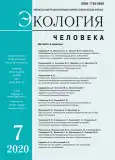OCCUPATIONAL HEALTH RISK ASSESSMENT AMONG THE WORKERS OF SMELTING SHOPS OF METALLURGICAL PRODUCTION
- Authors: Kir'yanova M.N.1, Plekhanov V.P.1, Markova O.L.1, Ivanova E.V.1
-
Affiliations:
- North-West Public Health Research Center
- Issue: Vol 27, No 7 (2020)
- Pages: 15-20
- Section: Articles
- URL: https://journals.rcsi.science/1728-0869/article/view/42416
- DOI: https://doi.org/10.33396/1728-0869-2020-7-15-20
- ID: 42416
Cite item
Full Text
Abstract
Full Text
##article.viewOnOriginalSite##About the authors
M. N. Kir'yanova
North-West Public Health Research Center
Email: mrn@ro.ru
кандидат медицинских наук, старший научный сотрудник Saint-Petersburg, Russia
V. P. Plekhanov
North-West Public Health Research CenterSaint-Petersburg, Russia
O. L. Markova
North-West Public Health Research CenterSaint-Petersburg, Russia
E. V. Ivanova
North-West Public Health Research CenterSaint-Petersburg, Russia
References
- Никанов А. Н., Чащин В. П., Дардынская И., Горбанев С. А., Гудков А. Б., Лагхайн Б., Попова О. Н., Дорофеев В. М. Риск-ориентированный подход к сохранению профессионального здоровья работников на предприятиях цветной металлургии в Арктической зоне Российской Федерации // Экология человека. 2019. № 2. С. 12-20.
- Плеханов В. В., Кирьянова М. Н., Фролова Н. М., Редченко А. В., Маркова О. Л. Иванова Е. В. Оценка профессионального риска здоровью работающих при производстве ферросплавов // Гигиена и санитария. 2017. № 96 (7). С. 682-685.
- Сорокин Г. А. Возрастная и стажевая динамика показателей здоровья, работающих как критерий для сравнения профессиональных и непрофессиональных рисков // Гигиена и санитария. 2016. № 4. С. 355-360.
- Суворов И. М., Чекоданова Н. В. Результаты динамического наблюдения за состоянием здоровья плавильщиков кобальта // Профессиональная патология при воздействии металлов: сб. науч. трудов. М., 1981. С. 11-15.
- Сюрин С. А., Чащин В. П., Фролова Н. М. Риск развития и особенности профессиональной патологии у работников цветной металлургии Кольского Заполярья // Медицина труда и промышленная экология. 2015. № 2. С. 22-26.
- Фридлянд И. Г. Значение неблагоприятных производственных факторов в возникновении и течении некоторых заболеваний. М.: Минздрав России, 2003. 268 с.
- Экспресс-метод количественной гигиенической оценки условий труда женщин: пособие для врачей. СПб., 1999. 40 с.
- Järvelä M., Huvinen M., Viitanen A. K., Kanerva T., Vanhala E., Uitti J., Koivisto A. J., Junttila S., Luukkonen R., Tuomi T. Characterization of particle exposure in ferrochromium and stainless steel production // J Occup Environ Hyg. 2016 Jul. Vol. 13 (7). P. 558-568; doi: 10.1080/15459624.2016.1 159687.
- Huvinen M., Pukkala E. Cause-specific mortality in Finnish ferrochromium and stainless steel production workers // Occup Med (Lond). 2016 Apr. Vol. 66 (3). P. 241-246; doi: 10.1093/occmed/kqv197. Epub 2015 Dec 8.
- Huvinen M., Pukkala E. Cancer incidence among Finnish ferrochromium and stainless steel production workers in 1967-201 1: a cohort study // BMJ Open. 2013 Nov 19. Vol. 3 (11). P. e003819; doi: 10.1136/bmjopen-2013-003819.
- Bala S., Tabaku A. Chronic obstructive pulmonary disease in iron-steel and ferrochrome industry workers // Cent Eur J Public Health. 2010 Jun. Vol. 18 (2). P. 93-98.
- Johnsen H. L., Hetland S. M., Benth J. S., Kongerud J., Soyseth V. Dust exposure assessed by a job exposure matrix is associated with increased annual decline in FEV1: a 5-year prospective study of employees in Norwegian smelters // Am J Respir Crit Care Med. 2010 Jun 1; Vol. 81(11). P 1234-1240; doi: 10.1164/rccm.200809-1381OC. Epub 2010 Mar 4.
- Johnsen H. L., Hetland S. M., Saltyte Benth J., Kongerud J., Soyseth V. Quantitative and qualitative assessment of exposure among employees in Norwegian smelters // Ann Occup Hyg. 2008 Oct. Vol. 52 (7). P. 623-633; doi: 10.1093/annhyg/men046. Epub 2008 Jul 24.
- Cheng Y. H., Liao C. M. BMI-based approach reveals direct impact of metal dust exposure on influenza-associated lung function decrement risk in smelters // J Hazard Mater. 2012 Oct 15. Vol. 235-236. P. 210-217; doi: 10.1016/j. jhazmat.2012.07.043. Epub 2012 Jul 28.
Supplementary files







